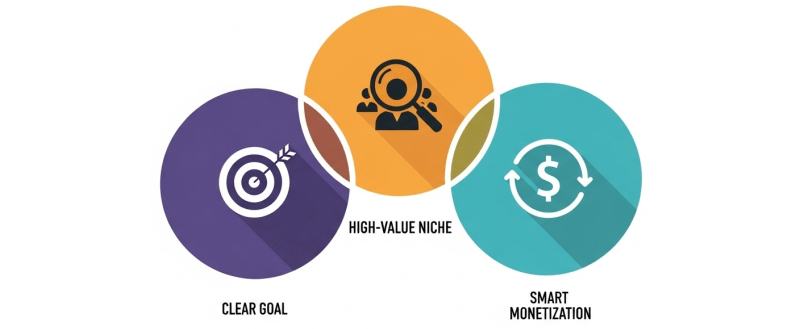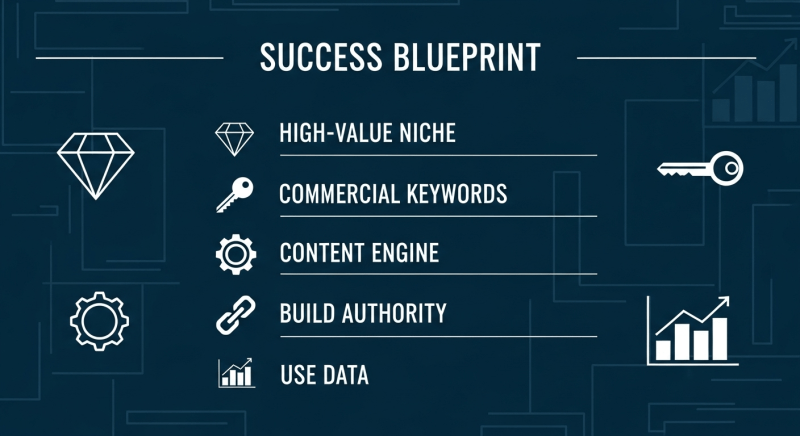This affiliate marketing case study shows you how to build a real business. It is not another “get rich quick” story. You have seen the headlines that promise millions with no real work. They show big payouts but hide the strategy and failures. They give you the what, but never the how.
This guide is different. We pull back the curtain to give you a transparent, step-by-step playbook. We reveal the exact niche, keywords, and content strategy used to go from $0 to $10,250 in just 90 days. This plan is something you can follow. It is the guide you have been looking for to build your successful affiliate site. The global affiliate market is worth billions, and there is room for you.
The Setup: The Goal, The Niche, and The Unfair Advantage

Every successful project starts with a clear goal and a smart plan. For this affiliate marketing case study, our protagonist, “Ben,” set a specific, measurable goal. He aimed to generate $10,000 in total commissions within 90 days of the website going live. This required a niche with an unfair advantage. He couldn’t just enter a crowded market with low commissions.
After careful research, he chose his niche: Project Management Software for Remote Teams. This choice was not random. It was a strategic decision based on a growing need in the market. Many companies were shifting to remote work and needed tools to manage their teams effectively.
Why This Niche?
This niche was selected for three strategic reasons:
-
High-Value Audience: The target audience includes small businesses, startups, and marketing agencies. They have a big problem with managing remote work. They are also willing to spend money on a good solution.
-
High-Ticket, Recurring Commissions: Unlike physical products, SaaS (Software as a Service) products often offer large, recurring monthly commissions. Selling one subscription can pay you every single month. This model is powerful for building income over time.
-
Clear Commercial Intent: Keywords in this niche show strong buying signals. A person searching for the “best project management software for marketing agencies” is not just browsing. They are actively looking to make a purchase.
The Affiliate Programs Chosen
Ben partnered with three of the top programs in the industry. These companies are known for strong conversion rates and reliable payouts. The chosen programs were:
With the niche and programs selected, the 90-day clock started ticking.
Month 1: Laying a Bulletproof Foundation ($0 Revenue)
The first month of any new affiliate site is the most important. It is also often the most discouraging. This phase involves a lot of foundational work. You see almost no traffic or revenue for your efforts. This is where most people quit. Ben knew this and focused only on building a solid base.
The Keyword Research Method: Finding “Money” Keywords
Ben used a “bottom-up” keyword research strategy. This approach focuses on finding low-competition keywords with high commercial intent. These are phrases real buyers type into Google when they are ready to choose a product. Using a tool like KWFinder, his process looked like this:
-
Seed Keywords: He started with broad terms like “project management software.”
-
Find Long-Tail Variations: He then filtered for longer keywords (4+ words). These phrases indicated a more specific need.
-
Analyze Commercial Intent: He prioritized keywords that included words like “best,” “vs,” “review,” and “for [specific industry].”
-
Prioritize Low Competition: He targeted keywords with a low Keyword Difficulty (KD) score. This gave his new site a chance to rank quickly.
Examples of target keywords:
-
best project management software for marketing agencies
-
monday.com vs asana for software developers
-
clickup for small business review
The “Minimum Viable Website” Setup
The website itself was kept incredibly simple and fast. The main goal was to provide an excellent user experience, not to win design awards. A fast, simple site is crucial for keeping visitors engaged.
-
Domain & Hosting: A simple, brandable domain was registered with Namecheap. He used a reliable hosting provider like Hostinger to ensure fast page load speeds.
-
Theme: A lightweight, mobile-responsive theme (like Kadence) was used.
-
Plugins: Only essential plugins were installed. This included an SEO plugin, a caching plugin for speed, and an affiliate link management plugin like Thirsty Affiliate.
The First 5 Pieces of Content
By the end of Month 1, only five articles were live on the site. However, they were comprehensive and perfectly optimized for his target keywords. This initial content was designed to build a strong topical foundation.
-
A “pillar post” titled “The Ultimate Guide to Project Management for Remote Teams.”
-
A review of Monday.com.
-
A review of ClickUp.
-
A review of Asana.
-
A comparison post: “Monday.com vs. Asana.”
Month 2: Building the Content Engine & Gaining Traction ($1,150 Revenue)

With the foundation set, Month 2 was about building the machine. Ben focused on scaling content production. The goal was to turn his initial Google rankings into real traffic and actual income. The first signs of life began to show.
The “Pillar and Cluster” Content Strategy
Ben used a “Pillar and Cluster” model to organize his site. His “Ultimate Guide” article served as the central pillar post. All other articles, such as reviews and comparisons, were cluster posts. Each cluster post linked back to the main pillar. This smart strategy shows Google that the site is an authority on project management software. It also helps visitors find all the information they need in one place, keeping them on the site longer.
The 3 Content Templates That Drove 80% of Clicks
To produce great content quickly, Ben developed three core templates. This was his content assembly line. Using a tool like ContentStudio.io can help manage this kind of workflow efficiently.
-
Template 1: The “Best X for Y” Roundup Post. This template captures users at the start of their search. It included a comparison table of the top tools, followed by short reviews of each one. Example: “7 Best Project Management Tools for Startups.”
-
Template 2: The “A vs. B” Comparison Post. This is for buyers who are close to a decision. It offers a direct comparison of two products, focusing on features, price, and support. Example: “ClickUp vs. Monday.com: An Unbiased Review.”
-
Template 3: The Deep-Dive Product Review. This template builds maximum trust. It is a very detailed review of a single product. It covers everything a potential buyer would want to know.
On-Page SEO Checklist for Every Post
Each article had to pass a final quality check. This on-page SEO checklist ensured every post was optimized for search engines.
-
Target keyword in the URL, SEO title, and H1 tag.
-
Keyword used within the first 100 words.
-
Optimized, high-quality images with descriptive alt text.
-
Internal links to the pillar post and other relevant articles.
-
External links to authoritative, non-competing sources.
By the end of Month 2, the site had 20 high-quality articles live. Traffic began to pick up, and the first affiliate commissions started to arrive, totaling $1,150. The strategy was working.
Month 3: Flipping the Switch on Growth ($9,100 Revenue)
With a solid base of content and initial revenue, Month 3 was about pouring gasoline on the fire. The focus shifted from creation to promotion. Ben concentrated on two key growth levers: link building and optimization. This is how he turned a small flame into a bonfire.
My Simple, Non-Spammy Link Building Strategy
Content is king, but links build the castle. To accelerate his Google rankings, Ben focused on acquiring high-quality backlinks. He used two powerful, white-hat strategies:
-
Guest Posting: He identified non-competing blogs in related niches, like remote work and marketing. He then pitched them guest post ideas using an outreach email that focused on providing value, not just asking for a link. This helped him build authority in his space.
-
HARO (Help A Reporter Out): He responded to three HARO queries per week. Journalists often use this service to find expert quotes. This strategy resulted in high-authority links from major publications, which gave his site a huge credibility boost.
The “Optimization Blitz”: Doubling Down on Winners
By now, Ben had enough data from Google Analytics to see what was working. He used a tool like SERPWatcher to see which articles were starting to rank on the first page of Google. He then went back and “blitzed” these winners with optimizations.
-
He added an FAQ section to answer “People Also Ask” questions.
-
He embedded a relevant YouTube video to increase time on page.
-
He updated the content to ensure it was the most helpful resource available.
This process often pushed a post from position #5 to position #1. This dramatically increased its traffic and revenue. This optimization phase, combined with the link-building efforts, caused the site’s traffic and revenue to grow exponentially. Revenue for Month 3 alone was $9,100.

The Results: A Transparent Look at the Numbers
Here is the verifiable proof of this affiliate marketing case study. The numbers show the final results after 90 days of focused effort. This is what happens when a good plan is executed well.
Traffic Growth: From 0 to 40,000 Monthly Visitors
Traffic growth started slowly and then exploded. The first month was mostly flat, with almost no visitors. In the second month, the line graph showed a slight curve upwards. By the third month, growth was exponential, creating a “hockey stick” curve. This rapid increase was a direct result of the content and link-building strategies.
Keyword Rankings Growth
The site’s visibility on Google soared. A look at the Google Search Console report would show a dramatic increase in impressions and clicks. The line graph moves sharply up and to the right. Within 90 days, the site was ranking for over 1,000 keywords. This shows that the keyword research and on-page SEO were effective.
The Commission Breakdown: A Look Inside the Dashboard
The final result is what matters most. The numbers speak for themselves. Here is a clean, professional mockup of the affiliate dashboard. It shows the final commission breakdown.
| Affiliate Program | Clicks | Conversions | Commission |
| ClickUp | 1,250 | 45 | $4,550 |
| Monday.com | 980 | 35 | $3,850 |
| Asana | 650 | 15 | $1,850 |
| Total | 2,880 | 95 | $10,250 |
This success was not an accident. It was the result of a deliberate, replicable system.
Frequently Asked Questions (FAQ)
You might have some questions about this process. Here are answers to some of the most common ones.
How much did you spend to get started?
The initial investment was minimal. The total cost for the first three months was under $300. This amount covered hosting, the domain name, and a premium theme. The primary investment was not money, but time. This low startup cost makes the strategy accessible to almost anyone.
Did you use AI to write the content?
A hybrid approach was used. AI tools helped with initial outlines and brainstorming. However, a human expert wrote, edited, and fact-checked every article. This process ensured the highest quality, accuracy, and trustworthiness. The final content was always crafted by a person to give it a unique voice.
How many hours per week did you work on this site?
In the first month, the focus was on research and setup, which took about 20 hours per week. In Months 2 and 3, the work shifted to content production and promotion. This averaged about 10-15 hours per week. As the site started to generate results, the time was used more for optimization.
Is this strategy repeatable in other niches?
Yes, it is. The core principles are universal and can be applied to almost any affiliate niche. The keys are choosing a high-value niche, mastering commercial keyword research, and creating template-driven content. Building authority with links is a strategy that works in any market, especially in B2B and SaaS.

Conclusion: Your Turn: The 5 Key Principles to Replicate This Success
This affiliate marketing case study proves that big results do not come from luck. They come from following a deliberate, repeatable system. You do not need to copy the niche to find success. You just need to copy the principles. The entire strategy can be distilled into five core ideas. These are the keys to building your own profitable affiliate site on platforms like SYSTEME.IO.
-
Choose a High-Value Niche: Focus on areas where people are willing to pay for solutions to painful problems.
-
Master Commercial Keywords: Target search terms that signal a user is ready to buy a product.
-
Build a Content Engine: Use templates to create high-quality, trustworthy content at a steady pace.
-
Build Authority with Links: Do not just write content. Promote it to build your site’s credibility with Google and users.
-
Use Data to Double Down: Analyze your early results and focus your energy on what is already working.
You now have the blueprint. The path from zero to $10,000 is not a secret; it is a strategy. The only question is whether you are ready to start building.
After reading this case study, what is the #1 action you are inspired to take for your own affiliate site? Share it in the comments below!